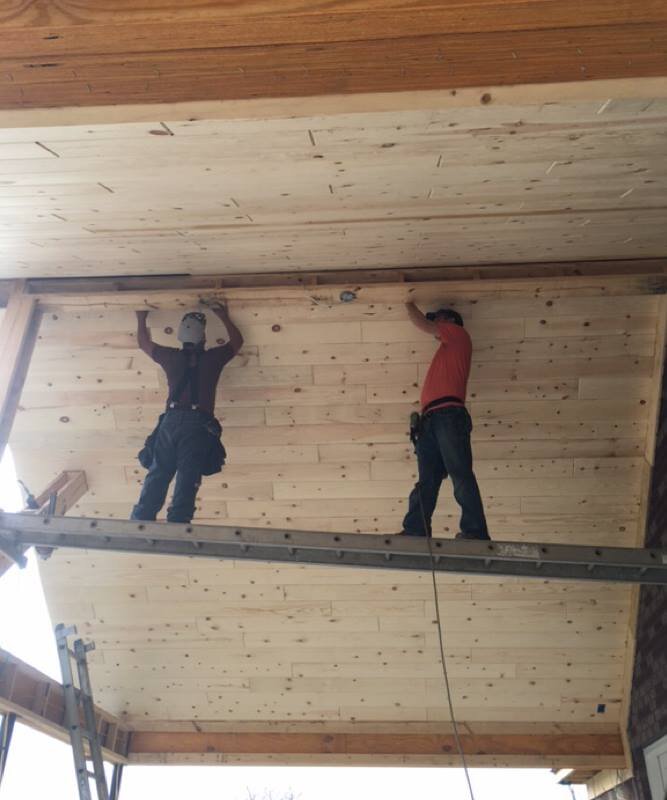How To Nail Lumber In Outside Wall
Installing Finish Lumber - Face Nailing
You've purchased your shiplap. You've unloaded it into the garage. Final weekend was spent meticulously staining each lath, and now you lot're set up to start installing it on your soon-to-be sleeping accommodation accent wall. You go to www.kylumber.com/blog to come across what you need to be able to adhere shiplap to drywall, and discover out that a cease nailer will probably work all-time for you, since you own one already, and nails are cheap! BUT….one question remains: Where do you shoot the nails???
We always recommend confront nailing shiplap and tongue and groove when installing it on your walls, ceiling, and as exterior siding. Confront nailing means that you shoot your nail at a 90 degree angle to the board through the flat (or face) of the board. For 6" and 8" boards, we shoot 3 nails into every stud/rafter, and for 10" and 12" boards, nosotros use 4 nails.
The mutual culling to confront nailing would exist toe-nailing, or "nailing through the joint". This is where the nail or staple is shot through the joint so that when the side by side board is installed, the boom hole is hidden. This method is most frequently used in hardwood flooring installations , since a boom, screw, or staple in the face of the board is rarely desired to be seen.
Why do we recommend face nailing, if it leaves the blast hole exposed? There's simply one reason, but it's wildly important to us, and think it is probably fifty-fifty more than important to you lot.
Face nailing keeps your lumber from moving.


Wood likes to move. It'due south a natural, fibrous material made of a complex organic polymer chosen lignin, which is what provides structure to the tree. Lignin easily absorbs and releases water molecules, making it swell and shrink as it changes wet content. This means that even afterwards you install the lumber, information technology will always exist "moving" every bit the humidity in your dwelling house changes. Pino's lignin construction is very loosely constructed, which allows information technology to bend and move very easily compared to oak, which has a very tight lignin construction. The more force you lot tin can utilize to the woods towards the surface to which information technology is attached, the less risk you run of the board warping, cracking, and cupping over the years.
When yous toe boom T&Yard, yous shoot the nail through the natural language at a 45 caste bending, and allow the joints to hold the board in place. This works well on floor because flooring boards are typically narrow, and have gravity to help hold them down. Notwithstanding, with shiplap, the joints do not inherently stay together, pregnant that if you were to only nail the rabbet on one side of the board, the other side would fall down. All widths of shiplap must exist face nailed, when installed correctly. For pino T&Thou, you tin become abroad with nailing at the articulation for half-dozen" widths, merely for annihilation wider, we highly suggest face up nailing the boards for a long-lasting and reliable installation
Cons of Face Nailing
-
Allows smash holes to evidence on face of board
-
Doesn't look as "make clean"
-
Uses more nails
-
Potentially irritating to those with OCD
Pros of Face Nailing
-
Helps to lock lumber in place
-
Keeps yous walls and ceilings looking new for longer
-
Makes you lot await like a pro when installing shiplap
-
Prevents cupping on ceiling terminate lumber and
broad-width floor
Do you lot accept more questions about installation techniques, tips, or tricks? Want to larn how to hide your smash holes? Give usa a shout on Facebook or call/text united states of america at (270)-847-0882 and we'll help you out!
How To Nail Lumber In Outside Wall,
Source: https://www.kylumber.com/blog/installing-finish-lumber-face-nailing
Posted by: martinezboothat.blogspot.com






0 Response to "How To Nail Lumber In Outside Wall"
Post a Comment